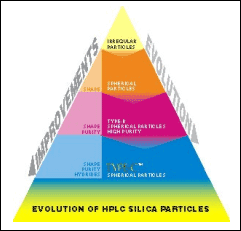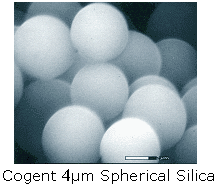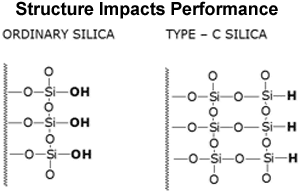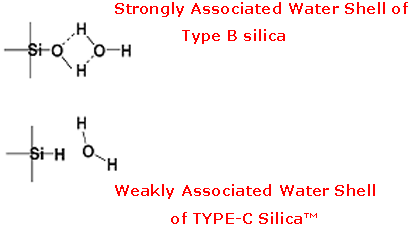 Evolution not Revolution; A History of Silica
Evolution not Revolution; A History of Silica
 Before the Introduction of Cogent TYPE-C Silica™
Before the Introduction of Cogent TYPE-C Silica™
 Introducing TYPE-C Silica™
Introducing TYPE-C Silica™
 Unique Surface Chemistry of TYPE-C Silica™ Products
Unique Surface Chemistry of TYPE-C Silica™ Products
 Hydration Shell, Liquid Stationary Phase type-B v. TYPE-C™
Hydration Shell, Liquid Stationary Phase type-B v. TYPE-C™
 Unique Bonding Capabilities Produce Unique Selectivities with
Problem Solving Benefits
Unique Bonding Capabilities Produce Unique Selectivities with
Problem Solving Benefits
 Separate Mechanisms for Separations
Separate Mechanisms for Separations
 Features and Benefits to Chromatographers
Features and Benefits to Chromatographers
|
Evolution not Revolution
A History of Silica
[Top]
Irregular shaped silica particles of wide pore size distribution were the original
support used to manufacture HPLC columns. At the time these supports were developed
they were the best technology available. Due to inherent deficiencies and inconsistencies
these columns limited chromatographers to the use of organic solvents and Normal
Phase Chromatography and were not very reproducible.
To achieve reverse phase separations, silica had to be bonded with low polarity
organo-silanes using siloxane bonding technology. These siloxane (Si-O-Si-C) bonds
used in this process can be hydrolytically susceptible to attachment failure and
during the lifetime of column can result in separation problems when working at
extreme pH or with strong buffers or ion pair reagents.

The development of spherical shaped silica particles of 10µm and later 5µm particle
size proved to be a great advancement in HPLC supports. The uniformity of shape
and size allowed for better packed columns which resulted in an increase in precision
and ruggedness. These tightly controlled particles did not create “fines”
as irregular shaped particles do resulting in columns that lasted longer and were
more stable. Even with this improvement, HPLC columns still suffered from frequent
tailing problems when basic compounds were separated at desired pH. Today, Reverse
Phase Separations are predominantly being performed on silica bonded with hydrocarbons
mostly C8 and C18.

The next evolution in HPLC support development was the High Purity
Silica which was specifically produced to minimize the amount of trace metals in
the silica lattice. Spherical silica manufactured with low metal content (especially
aluminum) minimizes the effect that the free, residual silanols would have on the
chromatography when they are ionized (high pH). This step forward was termed Type-B
silica to differentiate it from the lower purity, more acidic, higher metal content,
spherical silica which preceded it. This major advancement in chromatography produced
improved peak shape and increased pH tolerance and packed bed stability. Columns
not only lasted longer, but produced better chromatography for many compounds of
interest and were more stable.
|
Before the Introduction of Cogent TYPE-C Silica™
[Top]
... all silica based HPLC stationary phases had polar, acidic, silanol (Si-OH) functional
groups on the surface. Even with end-capping technology after exhaustive bonding,
as much as 30%-50% of the silanols remain un-bonded and can contribute to unwanted
separation results due to electrostatic interaction with solutes. To minimize type-B
silica silanols it may be desirous to use small end capping groups such as C1 to
cover these sites. The disadvantage of this concept is that these small groups are
readily hydrolyzed away in reverse phase solvents below pH 3. Therefore this column
technology is suited to a higher pH range; 6 to 9. Since many of the silanols sites
are not fully ionized in the mid pH range, using this it will cause a lack of precision
in the method. Silanols may be fully ionized (therefore do not contribute to lack
of precision) at the higher pH but higher pH causes dissolution of silica; end capping
is effective at retarding this dissolution (which begins to occur at and above pH
8). Most loss of retention at high pH is not due to loss of bonded phase and end
capping groups (lost to hydrolysis) as it is at low pH but is due to dissolution
of the underlying silica bed that results in the production of newly formed silanol
sites causing a change of carbon load and instability of the packed column.
Before the Introduction of Cogent TYPE-C Silica™...
...all other silica based HPLC stationary phases had mixed separation mechanisms
involving reverse phase type interactions with the bonded ligands and normal phase
type interactions with the silanols groups on the silica support. High carbon loadings
of HPLC columns (achieved through organic bonding schemes) were developed to minimize
this effect. The disadvantage of high carbon loading is that it reduces the ability
to separate highly polar compounds and limits the number of analytes successfully
separated with these phases although they can perform well for protonated compounds.
...to perform Organic-Normal Phase HPLC you were limited to un-bonded silica or
specialty bonded phases such as Cyano or Amino. Silica supports were hydroscopic
in nature and quite strongly retained water, the most polar common solvent used
and adsorbed by organic solvents variably depending on atmospheric conditions and
the type of solvent used. The stationary phase (Type B silica) then adsorbs the
water from the mobile phase due to free silanols and as the water content on the
support begins to increase, the retention of the analytes begin to change. Long
tedious steps had to be taken to tightly control the water content in the mobile
phase solvents.
Introducing TYPE-C Silica™
[Top]

Think Inside the Box... Solve difficult separation problems with your current
skill set and experience.
TYPE-C™ silica based HPLC columns have opened a new chapter in the book that
describes chromatographic supports and phases. Based on high purity-low metal content
Type-B silica, the manufacturing process for TYPE-C Silica™ continues where
others leave off. Our patented, proprietary process produces a surface populated
with silicon-hydride groups (SI-H) which are very stable and non polar. The TYPE-C
Silica™ support still has all the advantages of Type-B silica such as spherical
shape, low metal content, high purity, high mechanical strength, narrow pore size
distribution, wide range of pore sizes, easily chemically modified, no swelling
in the presence of solvents for stable packed beds and does not produce fines as
irregular silica. TYPE-C Silica™ products also have...
Unique Surface Chemistry of TYPE-C Silica™ Products
[Top]

The surface of TYPE-C Silica™ is predominantly populated with non-polar, silicon-hydride
(Si-H) groups instead of the polar, silanol groups (Si-OH) that dominate the surface
of previous varieties of silica. This feature of TYPE-C Silica™ particles,
gives it many unique, useful and helpful chromatographic qualities.
Some of the inherent limitations of Type-B silicas associated with free silanols
have been overcome with TYPE-C Silica™ products. These include but are not
limited to;
- surface acidity
- improved pH stability
- less hydroscopic
as well as a unique separation character that allows for improved aqueous based
reverse phase, organic solvent based normal phase and aqueous based normal phase
without an organic bonded stationary phase.
Hydration Shell, Liquid Stationary Phase type-B v. TYPE-C™
[Top]

There are two basic mechanisms that create retention of solutes in HPLC: partitioning
and adsorption. Partitioning can be defined as changes between two or more phases.
Adsorption can be defined as “attractive forces” between solutes and
a solid surface. HPLC columns have different retention phenomena taking place to
varying degrees on the Stationary and within the Mobile Phases.
The silica surface and bonded phase of HPLC columns are responsible for adsorption.
Partitioning takes place on the “quasi liquid phase layer” that forms
around the surface of the Stationary Phase. The “Liquid Stationary Phase”
is mostly formed by solvating it with water. This “hydration shell”
and the subsequent organic phase that forms around the Stationary Phase contributes
to the separation mechanism in conjunction with the underlying solid phase which
can have different functionalities at work. Depending on the bonded phase and liquid
phase that forms, the amount of partitioning will vary.
With Type-B silica, water is readily adsorbed onto the silica’s surface, which
contains active silanol groups; this strong adsorption of water forms a durable
“Hydration Shell” which is responsible for longer equilibration times
and lack of reproducibility in Normal Phase separations as well as other chromatographic
difficulties and is often the main cause of pH hysteresis and lack of reproducibility.
This is often the case in RP when using competitive, polar embedded phases.
Strong adsorption of water to type-B silica (shown above) makes using normal phase
chromatography very difficult. The silicon-hydride groups (Si-H) found on the surface
of TYPE-C Silica™ are not prone to such strong water retention (shown above)
as type-B silica making it an excellent choice for Organic-Normal Phase with improvements
in speed and range of solvent possibilities. The weaker water adsorption also accounts
for the little to no hysteresis observed when changing from Organic-Normal to Aqueous-Normal/Reverse
Phase with TYPE-C™ products or when changing pH with TYPE-C Silica™
based HPLC columns such as Cogent UDC-Cholesterol™. This feature makes the
column preferred over polar-embedded phases which often exhibit long term memory
effects. TYPE-C Silica™ products extend the useful range of Normal phase from
Hexane/Ethyl Acetate all the way to Water/Acetonitrile with excellent precision.
Unique Bonding Capabilities Produce Unique Selectivities with Problem Solving
Benefits
[Top]

Click here
to view NMR Spectra
Because of the unique silica surface, Cogent TYPE-C Silica can bond with any chemical
moiety which possesses either a terminal double or triple bond. Due the resulting
strong chemical bond between silicon and carbon, these bonded phases are much more
stable and resistant to conditions that can cause hydrolysis.
Initial products using the above bonding include Cogent TYPE-C Silica™, Cogent
UDC-Cholesterol™ (10 carbon straight chain with an ester linkage to cholesterol)
on TYPE-C Silica™, and Cogent Bidentate C18™ on TYPE-C Silica™.
These products will be sequentially released starting March 2003. The particle size
is 4µm, the pore size is 100A with 300A phases to be released during the year.
Separate Mechanisms for Separations
[Top]
Another unique feature of the Cogent TYPE-C Silica™ based products is that
the silica surface, with silicon-hydrides, can act independently of the bonded phase
giving it the ability to interact differently with non-polar to mid-polar compounds.
An example of this mechanism is the work done by MicroSolv on Metformin and Glyburide;
two anti-diabetic drugs of vastly different partition coefficients. When separating
these two compounds as a single mixture, the Cogent TYPE-C™ Silica column
produces good separation of the compounds with good peak shape for Glyburide and
alightly tailing peak shape for Metformin. All other features of the TYPE-C™
series are evident in the separation. When the Cogent UDC-Cholesterol™ column
is used instead of the Silica column the peak shape is excellent for both compounds.
This suggests that the bonded phase interacts differently from the silica surface
and that the silica surface is acting on the compounds similarly in both columns.
For a complete review of this work and how to apply it, please contact us.
Click here for a detailed description of how
this works.
|
Features and Benefits to Chromatographers
[Top]
Some Features of TYPE-C™ Columns:
|
Chromatographer’s Benefits
|
Silicon-Carbon Bonds instead of Siloxane
|
More stable and durable.
UDC-Cholesterol: pH 2.0 – 8.2
Bidentate C18: pH 1.5 – 10.0+ Bidentate C8: pH 1.5 – 10.0+
|
Si-H replaces Si-OH
|
Rapid equilibration between gradients
|
Temperature Stability Increased
|
Use Temperature as a selectivity Tool
|
Can be used with Hard Lewis Acids
|
Use Lewis Acids as Mobile Phase Additives
|
Free of Salts
|
Contaminant Free Surface
|
Bonded to a Silicon-Hydride Surface
|
Will not strongly bind Carboxylic Acids
or Sulfonic Acids
Minimized Silanophilic Activity
Stable at high flow rates (up to 3ml/minute)
|
Weakly Associated Hydration Shell
|
Water Friendly Columns, easy to use.
Very rapidly remove water from the stationary phase and silica.
|
Use 100% water on C18
|
Without loss of retention with time
|
Lack of pH hysteresis
|
Quickly change mobile phases and pH buffers.
|
Perform ANP & RP at the same time
|
Separate Polar & Non-Polar compounds in the same run
|
Retain Polar compounds at extremely high organic content
|
Increases sensitivity of mass detectors using ESI
|
User Non-Polar solvents
|
Retain & separate compounds which are non-soluble in water
|
Low affinity for water
|
Run normal phase separations on these "Bonded" columns without the hassles of moisture
in solvents
|
Use high organic % content in mobile phases
|
Shorten sample prep time. No need to dry down samples after SPE. Inject sample diluent
(high organic) right on the column
|
Bonded phase that performs ANP & RP
|
Get the performance of HILIC columns on a stable, robust bonded phase
|
High efficiency & stable
|
Great peak shapes & columns that last a long time
|
|
|
|